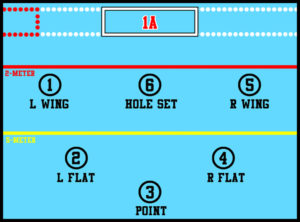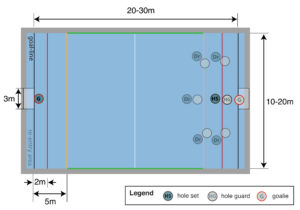Unlike a number of other sports, water polo has relatively few rules. While, learning the skills to be proficient at the sport takes time, even beginners can quickly pick up the basics.
BASIC RULES:
- 6 “Field” Players and 1 Goalie start the game. Teams consist of up to 15 players.
- Field players must pass, catch, and shoot with only 1 hand. Goalies may use 2 hands.
- Taking the ball under water when guarded is a turnover.
- The official playing field is at least 25 yards long, 20 yards wide, and 7 feet deep.
- Players may not touch the bottom or hang on the wall.
- Games consist of 4 quarters and typically last 45 minutes to 1 hour.
- There is a 30 second shot clock per possession.
- Minor fouls occur frequently and result in a free pass. There is no limit to minor fouls.
- After 3 major fouls (ejections), a player may not return to the game.
HOW MANY PLAYERS ARE THERE?
 Six “field players” swim, tread, pass and shoot in an attempt to score into a goal defended by a goalie. Basic water polo strategy is similar to basketball and soccer. Players anticipate a shot or turnover and counter-attack begins. The ball is advanced through dribbling or passing and proper spacing must be maintained. Once in a half- court, five perimeter players set up a semi-circle (or umbrella) around the center position (or hole set) who wrestles to maintain position on the 2-meter line, usually with his back to the goal. Perimeter players can pass, drive, set picks, and shoot. Once the center (a.k.a. hole set or 2-meter position), receives the ball, he or she must overpower his or her defender for a shot or earn an ejection in the process. Defenses play man-to-man, zone, or a combination of both. Positions in the pool are identified by names and numbers, listed in the diagram below:
Six “field players” swim, tread, pass and shoot in an attempt to score into a goal defended by a goalie. Basic water polo strategy is similar to basketball and soccer. Players anticipate a shot or turnover and counter-attack begins. The ball is advanced through dribbling or passing and proper spacing must be maintained. Once in a half- court, five perimeter players set up a semi-circle (or umbrella) around the center position (or hole set) who wrestles to maintain position on the 2-meter line, usually with his back to the goal. Perimeter players can pass, drive, set picks, and shoot. Once the center (a.k.a. hole set or 2-meter position), receives the ball, he or she must overpower his or her defender for a shot or earn an ejection in the process. Defenses play man-to-man, zone, or a combination of both. Positions in the pool are identified by names and numbers, listed in the diagram below:

HOW BIG IS THE POOL?
Olympic and collegiate pool size is 30 meters x 20 meters. A typical age group pool size is 25 meters x 6 lanes. Three colored markers define the water polo course. Red markers indicate the 2-meter line. An o ensive player without the ball will be whistled o sides if found “inside” the red marker unless a teammate has advanced the ball inside the 2-meter line at the same time (a.k.a. 2-meter violation) Yellow markers indicate the 5-meter line. If an o ensive player is fouled behind the yellow marker, he/she may shoot immediately (no faking or hesitating) or take a free pass. If an o ensive player is fouled inside the yellow marker, he/ she must take a free pass. White markers indicate mid-pool. After a goal, play re-starts at mid-pool. Goalies cannot cross the white marker.

HOW LONG IS A GAME?
Games are divided into four quarters. Quarter length depends on the level of play. Olympic and collegiate quarters are eight minutes. Age group quarters are typically five to six minutes. Games usually last 45 minutes to an hour. Teams have 30 seconds to possess the ball before they must take a shot or dump the ball. Shot clocks are re-set after turnovers, shots on goal and ejection fouls. Shot and game clocks stop when the ball is not “in play” (the time between a foul occurring and a free throw being taken) or a goal is scored.
WHY ARE THERE SO MANY WHISTLES?
 Fouls are critical to the strategy and flow of a water polo game. They occur frequently and there is no limit to the number of minor or ordinary fouls that a player can commit. Unlike most sports, committing fouls is not necessarily a bad strategy and can be used by the defense to it’s advantage. Ejections and penalties are less common and less advantageous. After committing 3 major fouls, a player is excluded from the remainder of the game. Referees signal fouls by blowing their whistle and pointing their arm in the direction of the team that was awarded the foul.
Fouls are critical to the strategy and flow of a water polo game. They occur frequently and there is no limit to the number of minor or ordinary fouls that a player can commit. Unlike most sports, committing fouls is not necessarily a bad strategy and can be used by the defense to it’s advantage. Ejections and penalties are less common and less advantageous. After committing 3 major fouls, a player is excluded from the remainder of the game. Referees signal fouls by blowing their whistle and pointing their arm in the direction of the team that was awarded the foul.
- One whistle: minor/ordinary foul (o ense keeps the ball)
- Two whistles: o ensive foul (defense gets the ball)
- Three (or more) whistles: major/personal foul (offense keeps the ball; shot clock resets; defender is ejected for 20 seconds)
Ordinary (minor) Fouls
Most ordinary fouls take place around the ball. After a minor foul, a member of the fouled team must put the ball in play by taking a free throw. The most common ordinary foul occurs when a defender reaches over their opponent and makes bodily contact when trying to steal or reach for the ball. Players in possession of the ball will often attempt to “draw” a foul in order earn a free pass. To draw a foul, the o ensive player must let go of the ball and show the referee that he/she is being held while keeping his/her head above water. O ensive fouls occur when an attacker pushes o a defender to provide space for a pass or shot, touches the ball with 2 hands, takes the ball under water, or goes inside the 2 meter line without the ball. A delay of the game can also result in a minor foul.
Major Fouls – Ejections (a.k.a. kickouts) & Penalties.
The most common major foul occurs when a defensive player holds, sinks, or pulls back an attacking offensive player before he or she can possess the ball. Other major fouls include interfering with a free pass, kicking/striking an opposing player, or talking back to the official.  Ejections result in the player being excluded for 20 seconds, causing his/her team to be temporarily down a player (man-down). Another common major foul is a penalty foul. A Penalty foul occurs when a defensive player that prevents a probable score by committing a foul within 5m of the goal that. After a penalty foul, the o ensive team is awarded a penalty shot from 5M out. If a player commits three major fouls, they must sit out the remainder of the game. Please note that officiating is subjective and open to interpretation by the referees.
Ejections result in the player being excluded for 20 seconds, causing his/her team to be temporarily down a player (man-down). Another common major foul is a penalty foul. A Penalty foul occurs when a defensive player that prevents a probable score by committing a foul within 5m of the goal that. After a penalty foul, the o ensive team is awarded a penalty shot from 5M out. If a player commits three major fouls, they must sit out the remainder of the game. Please note that officiating is subjective and open to interpretation by the referees.
WHAT IS ADVANTAGE? WHY IS THE REF CONDONING THE DROWNING OF MY CHILD?
The referee may refrain from declaring a foul, if in his judgment this would give an advantage to the offender’s team. The referees will not declare an ordinary foul when there is still a possibility to play the ball. A player with their hand on top of the ball will  rarely be awarded an ordinary foul for this reason.
rarely be awarded an ordinary foul for this reason.
The referees shall apply this principle to the fullest extent and must allow the offensive player every opportunity to “legally” overpower their opponent in an attempt to score. Similar to soccer, continuation of “advantage” by the attacking player should NOT be taken away by a called foul or stoppage of play. However, any foul that endangers a player’s safety, especially a foul around a player’s head and neck, should be called.

